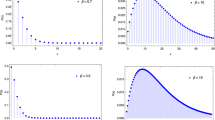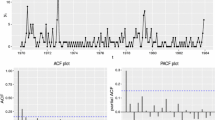Abstract
Overdispersion is a phenomenon commonly observed in count time series. Since Poisson distribution is equidispersed, the INteger-valued AutoRegressive (INAR) process with Poisson marginals is not adequate for modelling overdispersed counts. To overcome this problem, in this paper we propose a general class of first-order INAR processes for modelling overdispersed count time series. The proposed INAR(1) processes have marginals belonging to a class of mixed Poisson distributions, which are overdispersed. With this, our class of overdispersed count models have the known negative binomial INAR(1) process as particular case and open the possibility of introducing new INAR(1) processes, such as the Poisson-inverse Gaussian INAR(1) model, which is discussed here with some details. We establish a condition to our class of overdispersed INAR processes is well-defined and study some statistical properties. We propose estimators for the parameters and establish their consistency and asymptotic normality. A small Monte Carlo simulation to evaluate the finite-sample performance of the proposed estimators is presented and one application to a real data set illustrates the usefulness of our proposed overdispersed count processes.


Similar content being viewed by others
References
Abraham B, Balakrishna N (2002) Inverse gaussian autoregressive models. J Time Ser Anal 20:605–618
Alamatsaz MH (1983) Completeness and self-decomposability of mixtures. Ann Inst Stat Math 35:355–363
Aly EEAA, Bouzar N (1994) Explicit stationary distributions for some galton-watson processes with immigration. Stoch Models 10:499–517
Al-Osh MA, Alzaid AA (1987) First-order integer valued autoregressive (INAR(1)) process. J Time Ser Anal 8:261–275
Anderson TW (1971) The statistical analysis of time series. Wiley, New York
Andersson J, Karlis D (2014) A parametric time series model with covariates for integers in \(\mathbb{Z}\). Stat Model 14:135–156
Barreto-Souza W (2015) Zero-modified geometric INAR(1) process for modelling count time series with deflation or inflation of zeros. J Time Ser Anal 36:839–852
Barreto-Souza W, Bourguignon M (2015) A skew INAR(1) process on \(\mathbb{Z}\). Adv Stat Anal 99:189–208
Bisaglia L, Canale A (2016) Bayesian nonparametric forecasting for INAR models. Comput Stat Data Anal 100:70–78
Forst G (1979) A characterization of self-decomposable probabilities in the half-line. Zeit Wahrscheinlichkeitsth 49:349–352
Freeland RK, McCabe BPM (2004a) Analysis of low count time series data by Poisson autoregression. J Time Ser Anal 25:701–722
Freeland RK, McCabe BPM (2004b) Forecasting discrete valued low count time series. Int J Forecast 20:427–434
Freeland RK, McCabe BPM (2005) Asymptotic properties of CLS estimators in the Poisson AR(1) model. Stat Prob Lett 73:147–153
Hamilton JD (1994) Time series analysis. Princeton University Press, Princeton
Harvey AC, Fernandes C (1989) Time series models for count or qualitative observations. J Bus Econ Stat 7:407–417
Jazi MA, Jones G, Lai CD (2012) First-order integer valued processes with zero inflated poisson innovations. J Time Ser Anal 33:954–963
Jung RC, Tremayne AR (2011) Useful models for time series of counts or simply wrong ones? Adv Stat Anal 95:59–91
Karlis D, Xekalaki E (2005) Mixed Poisson distributions. Int Stat Rev 73:35–58
Karlsen H, Tjostheim D (1988) Consistent estimates for the NEAR(2) and NLAR(2) time series models. J R Stat Soc Ser B 50:313–320
McKenzie E (1985) Some simple models for discrete variate time series. Water Resour Bull 21:645–650
McKenzie E (1986) Autoregressive moving-average processes with negative binomial and geometric marginal distributions. Adv Appl Probab 18:679–705
McKenzie E (1988) Some ARMA models for dependent sequences of Poisson counts. Adv Appl Probab 20:822–835
McKenzie E (2003) Discrete variate time series. In: Rao CR, Shanbhag DN (eds) Handbook of statistics. Elsevier, Amsterdam, pp 573–606
Meintanis SG, Karlis D (2014) Validation tests for the innovation distribution in INAR time series models. Comput Stat 29:1221–1241
Nastić AS, Ristić MM (2012) Some geometric mixed integer-valued autoregressive (INAR) models. Stat Probab Lett 82:805–811
Nastić AS, Ristić MM, Djordjević MS (2016a) An INAR model with discrete Laplace marginal distributions. Braz J Probab Stat 30:107–126
Nastić AS, Laketa PN, Ristić MM (2016b) Random environment integer-valued autoregressive process. J Time Ser Anal 37:267–287
Nastić AS, Ristić MM, Janjić AD (2016c) A mixed thinning based geometric INAR(1) model. Filomat
Pillai RN, Satheesh S (1992) \(\alpha \)-inverse Gaussian distributions. Sankhya A 54:288–290
Ridout MS (2009) Generating random numbers from a distribution specified by its Laplace transform. Stat Comput 19:439–450
Ristić MM, Nastić AS, Ilić AVM (2013) A geometric time series model with dependent Bernoulli counting series. J Time Ser Anal 34:466–476
Ristić MM, Bakouch HS, Nastić AS (2009) A new geometric first-order integer-valued autoregressive (NGINAR(1)) process. J Stat Plan Inference 139:2218–2226
Ristić MM, Nastić AS, Bakouch HS (2012) Estimation in an integer-valued autoregressive process with negative binomial marginals (NBINAR(1)). Commun Stat 41:606–618
Schweer S, Weiß CH (2014) Compound Poisson INAR(1) processes: stochastic properties and testing for overdispersion. Comput Stat Data Anal 77:267–284
Scotto MG, Weiß CH, Gouveia S (2015) Thinning-based models in the analysis of integer-valued time series: a review. Stat Model 15:590–618
Steutel FW, van Harn K (1979) Discrete analogues of self-decomposability and stability. Ann Probab 7:893–899
Weiß CH (2008a) Thinning operations for modeling time series of counts-a survey. Adv Stat Anal 92:319–341
Weiß CH (2008b) Serial dependence and regression of Poisson INARMA models. J Stat Plan Inference 138:2975–2990
Weiß CH (2009) Controlling jumps in correlated processes of Poisson counts. Appl Stoch Models Bus Ind 25:551–564
Weiß CH (2013) Integer-valued autoregressive models for counts showing underdispersion. J Appl Stat 40:1931–1948
Weiß CH (2015) A Poisson INAR(1) model with serially dependent innovations. Metrika 78:829–851
Weiß CH, Homburg A, Puig P (2016) Testing for zero inflation and overdispersion in INAR(1) models. Stat Pap
Weiß CH, Kim HY (2013) Binomial AR(1) processes: moments, cumulants, and estimation. Statistics 47:494–510
Yang K, Wang D, Jia B, Li H (2016) An integer-valued threshold autoregressive process based on negative binomial thinning. Stat Pap
Acknowledgements
I thank the two anonymous referees and the Associated Editor for their useful suggestions and comments that led to an improved version of this article. I also thank the financial support from CNPq (Brazil) and FAPEMIG (Brazil).
Author information
Authors and Affiliations
Corresponding author
Appendix
Appendix
We here derive the asymptotic covariance matrix of the weak convergence given in Proposition 4. For this, we will use joint moments, which are defined by
where \(0\le s_1\le \ldots \le s_r\) and r belongs to \(\mathbb N\). Expressions of joint moments up to fourth order for INAR(1) processes were obtained by Schweer and Weiß (2014) (Theorem 3.3.1). We will use these expressions for computing the desired asymptotic covariance matrix.
Let \(Y_n\), \(Z_n\) and \(W_n\) be as defined in Sect. 4 and define \(g_n(i,j)=n{-}i{-}\frac{\alpha ^j}{1-\alpha ^j}\big (1-\alpha ^{j(n-i)}\big )\), for \(i,j\in \mathbb N\). Using joint moments and their expressions given in Theorem 3.3.1 from Schweer and Weiß (2014), after some manipulations we obtain that
and
where \(\mu =E(X_n)\), \(\kappa _j=E((X_n-\mu )^j)\) and \(\mu _j=E(X_n^j)\), for \(j=2,3,4\).
Let \(\Sigma _n\) be the covariance matrix with the above terms. Hence, it follows that the covariance matrix \(\Sigma \) of the Proposition 4 can be obtained by \(\Sigma =\displaystyle \lim _{n\rightarrow \infty }\Sigma _n/n\).
Rights and permissions
About this article
Cite this article
Barreto-Souza, W. Mixed Poisson INAR(1) processes. Stat Papers 60, 2119–2139 (2019). https://doi.org/10.1007/s00362-017-0912-x
Received:
Revised:
Published:
Issue Date:
DOI: https://doi.org/10.1007/s00362-017-0912-x




